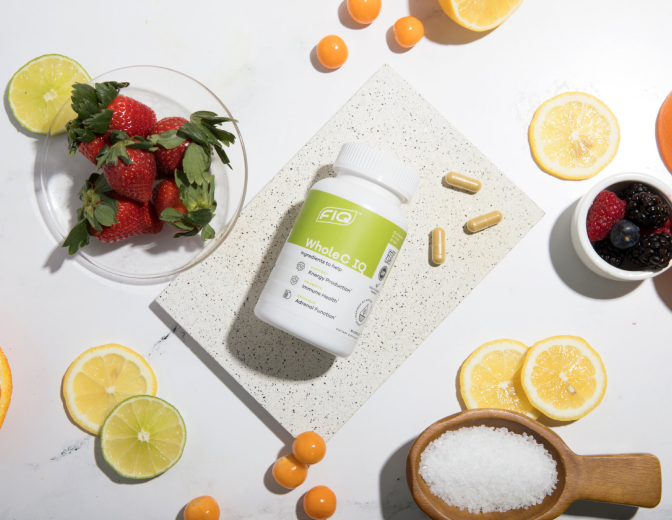Without histamine, our bodies could not effectively fight off pathogenic invaders. It serves as a signaling molecule to mast cells and basophils to activate their immune response, and it causes capillaries to “leak” so proteins and white blood cells can migrate to the site of infection.3 High levels are found in skin, mucosa, and bronchial tissue. Most endogenous histamine is produced by mast cells and basophils.2
Too much histamine production has long been known to cause issues varying from allergic reactions, hives, stomach aches, diarrhea, and migraines.3 There are several different receptors for histamine. Its local physiological function is determined by the particular receptor activation.2
- H1 receptors - allergic reactions, motion sickness, and anaphylaxis.
- H2 receptors - gastric acid secretions (ulcers, GERD, GI issue connection to HIT).
- H3 receptors - act in neurotransmission, sleep/wakefulness, cognition, epilepsy, and pain.
- H4 receptors - are involved in immune responses to myocarditis, cancers, autoimmune diseases, and inflammation.4
Histamine Intolerance
Histamine intolerance (HIT) is now a widely recognized and accepted disorder, though its exact etiology has yet to be fully understood. The World Allergy Association classifies HIT as a non-allergy-mediated food intolerance.5HIT is defined as a state where the production of histamine exceeds the body’s ability to clear it. Because histamine and its respective receptors are prevalent throughout the body, this can result in a plethora of disturbances across various tissues.3
Histamine is degraded by an enzyme called diamine oxidase (DAO).6 Some researchers have suggested that HIT is predominantly caused by low DAO production caused by genetic mutations or as a secondary cause that inhibits DAO production.6 However, a recent study found low DAO levels in 44% of participants who did not have HIT,7 suggesting that it may include other etiologies.
Where does Histamine Come From
We’re exposed to exogenous histamines from foods, including aged cheese, tomatoes, cured meats and fish, and wines.8 Our body makes extracellular histamine from histidine.9 Some species of gut bacteria also produce histamine.10Overactive mast cells also result in the overproduction and release of histamine.11 This disorder is called mast cell activation syndrome (MCAS); some researchers have suggested that because of the remarkable overlap in clinical manifestations of HIT and MCAS symptoms, it may actually be the same disorder.12
The mechanisms and causes of HIT are likely a combination of all factors listed above. The biggest problem with histamine is that it’s part of a positive feedback loop - the presence of histamine encourages the release of more histamine. So, a rational intervention should take a multi-factorial approach.
1. Enhancing Histamine Breakdown and Clearance
At the root of HIT lies the issue of excess histamine. Studies show that enhancing the body's ability to degrade and clear it universally impedes histamine-related symptoms.13 Diamine oxidase has proven to be the most promising nutritional therapy for enhancing histamine breakdown.13, 14Oral routes of DAO supplementation have been shown to be most effective in supporting HIT.13, 14, 15 Several cells and tissues produce DAO, but when histamine levels exceed the capacity of endogenous DAO production, preventing the absorption of histamine in the gut with DAO appears to hinder systemic histamine reactivity.13, 14, 15
2. Blocking Histamine Release
Because histamine has a positive feedback effect, blocking its further release from cells is another important layer for supporting HIT.16 Some herbs and extracts have exhibited potent histamine-blocking properties.Nettle has long been used as a natural allergy-support agent. In-vitro studies have revealed strong histamine-blocking properties. Nettle inhibits signals to mast cells to prevent them from degranulating and releasing histamine.17 Quercitin has also shown potent histamine-blocking properties.18
3. Blocking Histamine Receptors
When histamine binds to cell receptors, it initiates specific actions that result in symptoms like itching, watery eyes, GI symptoms, bronchodilation, etc. It’s also the first step in the cascade that causes cells to release more histamine.3, 4Nettle has been shown to bind to H1 receptors to block histamine.17, 18 Bromelain has shown multifaceted effects on blocking histamine receptor responses.19 It appears to block H1 receptor activity and reduces the stimulation of other immune cells by histamine.19 Holy basil acts on both the H1 and H2 receptors to reduce histamine signaling.20
4. Calming Mast Cells
Mast cells are the most significant contributor to histamine release. They can sometimes become sensitized and overreact to harmless compounds, and they respond to the presence of histamine by releasing more of it- creating a vicious cycle. Calming mast cell activation can play a considerable therapeutic role in HIT.12Nettle and bromelain potently reduce mast cell degranulation.17, 18, 21 Quercetin is another potent natural agent commonly used to support MCAS due to its powerful multifaceted influence on mast cells, including blocking mast cell cytokine release,22 inhibiting receptor responses of mast cells,23 and reducing histamine release and response of mast cells.24
Ursolic acid also reduces mast cell activation by blocking FcεRI-mediated mast cell activation25, 26 and inhibits their release of histamine.27
The First Full Spectrum Supplement
Histamine IQ is the first full-spectrum histamine-support supplement with ingredients that enhance the clearance and breakdown of histamine, reduce further production and release, support appropriate mast cell function, and modulate histamine receptor function.
Lifestyle factors have also been suggested as important mediators for HIT support. These include supporting a healthy gut microbiome, reducing the intake of high-histamine foods, and regulating emotional stress. Combined with Histamine IQ, these can help further support healthy immune function and well-being.




